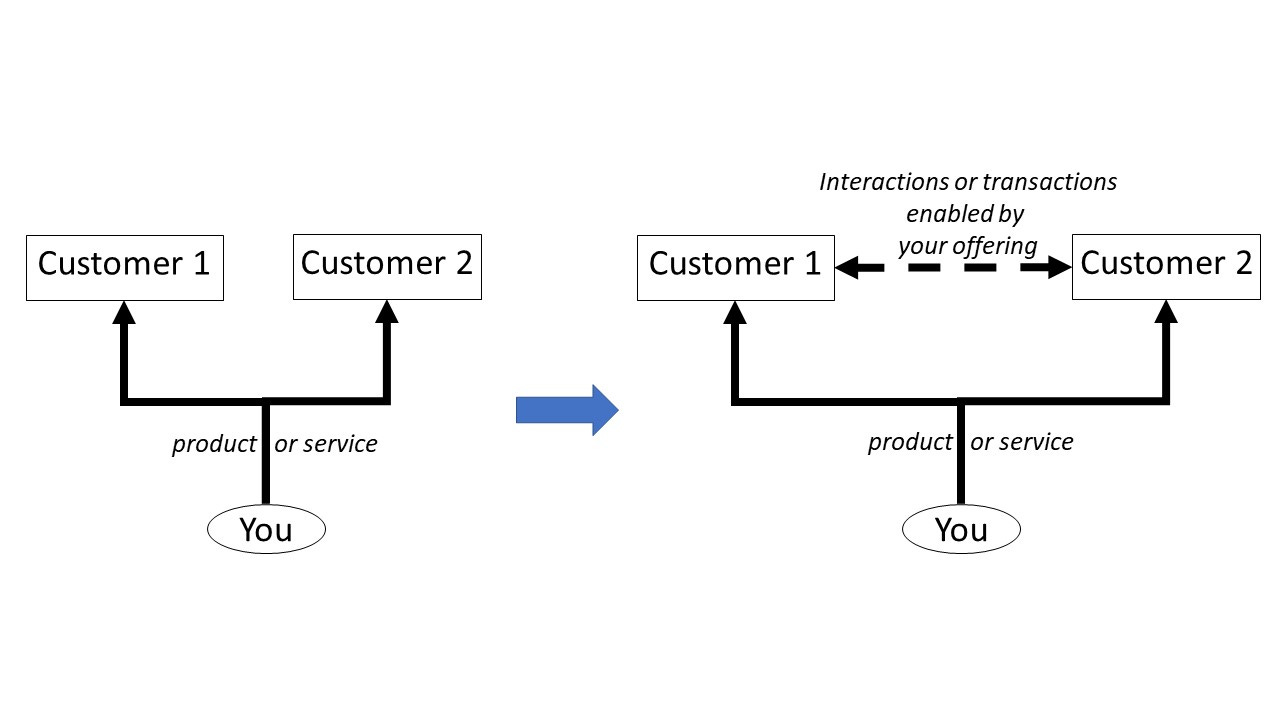Product-to-platforms part II: connecting customers
This is the second method for turning products into platforms, following on our first post on this topic. Rather than bringing any new third parties on board and connect them to customers, the idea here is to enable interactions or transactions between existing customers, thereby creating network effects.
There are many examples of firms modifying products/services to connect customers:
After Intuit realized that many of the small business customers of its QuickBooks product were looking for accountants and that many independent accountants (who are also QuickBooks customers) were looking for clients, Intuit added a matchmaking function within QuickBooks that allows small businesses to find and contact accountants with relevant expertise in their geographic area.
Ganz equipped each of its popular stuffed animal Webkinz toys with a playable online counterpart. The owner of each toy can activate the digital avatar via a secret code and then play with other toy owners in the virtual Webkinz World.
Many brands set up customer forums to enable their customers to communicate with each other. The goal is to allow customers to share knowledge and provide useful tips to each other, so that they can get the best experience out of the products. Examples include Wolfram Mathematica’s vibrant user forum, Tesla’s online community (for discussing issues regarding its various car models) and platform for clubs (enabling owners and enthusiasts to create and manage local Tesla clubs).
Over the last decade, many firms have been created to democratize access to alternative investments, e.g. AngelList for startups, Masterworks for art, Vinovest for wine, Prosper for debt products, Rally for collectibles. Each of these firms could potentially allow its customers to trade among themselves, buying and selling the assets that the firm creates securities in. This secondary market would add obvious value when these assets are not already tradable in regular markets. Masterworks, for example, has done this for the paintings it has sold to its investors, allowing those investors to sell their shares of paintings to other members.
During COVID-19, with movie theatres shut down, there has been an increased demand by people wanting to watch movies together via streaming services. This provided an obvious opportunity for streaming services to connect their subscribers in watch parties. This opportunity was first seized by third-party providers like Teleparty and Scener, although more recently streaming firms have got in on the act (Amazon prime Watch Party, Hulu Watch Party and Disney Plus Group Watch). The advantage over using a third-party service is there are no extra plugins or setup complications, so it becomes easier for subscribers to use. Surprisingly, Netflix, the largest streaming service, is late to this party.
We would be remiss not to mention some less-than-stellar attempts to turn products into platforms by connecting customers. Since the Harvard Business Review article was published in 2017, we have sometimes joked with students and companies we advise that if they run out of ideas for what kind of interactions they might enable between their customers, they can always try adding a dating app feature to whatever product/service they are selling. As it turns out, reality is stranger than fiction. Sometime in late 2018-2019, Samsung launched a dating service around its smart refrigerators called Refrigerdating, which allows people to match for dating purposes based on the contents of their respective fridges. The jokes practically write themselves (see for example this Guardian article), so we will just stick to pointing out that this is a good illustration of attempting to turn a product into a platform by connecting customers. A similar idea was implemented by Virgin America/Atlantic starting back in 2013: Virgin equipped its in-flight touchscreen system with the ability to send messages to passengers in other seats on the flight, as well as to order them drinks. This capability was initially pitched by Sir Richard Branson himself as an inflight flirting system, and later pivoted into an inflight business networking system (apparently, several airlines offer some version of the latter).
An interesting tactical question that arises is whether the connections enabled around the original product should be limited to customers only, or whether non-customers can also be allowed to participate. For instance, BMW’s community is exclusive to BMW drivers/owners, whereas Tesla’s communities and clubs are also open to “enthusiasts”. Similarly, anyone can search for a professional accountant on the QuickBooks Find a ProAdvisor website. And GoPro’s channel is available to anyone via YouTube, Xbox and other platforms, so accessing it does not require having a GoPro camera. The tradeoff is between creating stronger network effects around the actual product (when the connections are exclusive to customers) vs. creating more awareness/virality for the product (when the connections are also open to non-customers). Different companies/products at different stages of their lifecycle may come down on either side of this tradeoff, depending on whether they wish to enhance defensibility vs. boost growth.
It is worth pointing out that connecting customers can also be done across multiple products (sold by the same firm) instead of around the same product.
For instance, 23andMe is known for its popular DNA testing service: the company sends users a kit in the mail, users spit in the plastic tube that is included, send it in, and then get access to their biological data in an online account. As its user base has increased to over 5 million, 23andMe has accumulated a valuable database of genetic information since 80% of its customers consent having their data used for research. Starting in 2018, 23andMe started monetizing this data by selling access to it (anonymized) to pharmaceutical companies. This did not turn it into a platform – it simply opened a new line of business. However, 23andMe could now connect the two lines of business into a platform with network effects in the following way: make it possible for participating pharma companies to use the data they buy in order to select consenting 23andMe users based on their genetic profiles for double-blind clinical trials (with compensation for the users). Conversely, they could allow users to reach out to participating pharma or medical treatment companies for personalized medicine. The same tactical question discussed above applies here: should 23andMe restrict access to its users (for clinical trial purposes) to companies that also buy genetic data from it, or open that service up to any company? The answer is driven by the same considerations.
So, what are the key benefits of becoming a platform by connecting customers? First, doing so usually results in increased demand for and stickiness of the core product(s) due to network effects. This also means better defensibility of the core product(s) against competitors. Second, becoming a platform can potentially create new revenue streams: for instance, Ganz sells digital goods/services in the Webkinz World; and Masterworks could charge a small fee for each transaction in the secondary market if it wanted to.
At the same time, there are a few key pitfalls to be mindful of. First and most obviously, adding an extension that connects customers can be quite a complex (and expensive) undertaking, so better be sure the upside is worth the cost. Just imagine how much harder it is for Ganz to create and manage a virtual world for the avatars of its plush toys than to just stick to selling the toys. Second, in some cases, the ability for customers to connect with each other may create a negative externality on the initial product/service when the connections lead to bad interactions/transactions. In particular, the provider may be held responsible for bad interactions/transactions mediated among its customers. For instance, the Virgin inflight flirting capability did predictably lead to at least one instance of harassment, which left the company scrambling to explain that this was not a feature but rather a bug of the flying experience it endeavors to offer its customers.
If you enjoyed reading this, sign up now so you will receive our posts directly in your inbox as they are published.
In the meantime, tell your friends!






